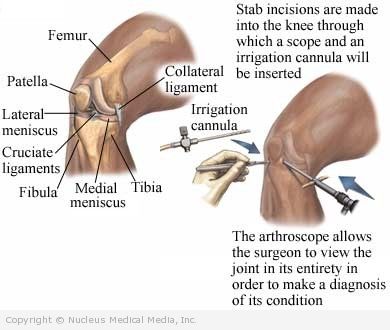Arthroscopy
(Fiberoptic Joint Examination)
Arthroscopy – Definition
Arthroscopy is a surgery done to examine a joint visually. Most of the time, it is done on larger joints, like the knee or shoulder. A special tool called an arthroscope is used. It is an instrument that looks like a long tube with a miniature camera on the end. Repairs or corrections to the joint may be done by using the arthroscope and other tools.
Arthroscopy – Reasons for Procedure
It is used to see, diagnose, and treat problems inside your joint. The procedure is most often performed for the following reasons:
- Diagnose an injury or disease inside a joint
- Remove bone or cartilage
- Repair tendons or ligaments
Arthroscopy – Possible Complications
Complications are rare, but no procedure is completely free of risk. If you are planning to have an arthroscopy, your doctor will review a list of possible complications, which may include:
- Infection
- Blood clots
- Swelling or bleeding
- Damage to blood vessels, nerves, or other tissue
- The need to have another surgery or more extensive surgery
Factors that may increase the risk of complications include:
- Pre-existing heart or lung condition
- Obesity
- Recent or chronic illness
- Diabetes
- Bleeding disorders
- Smoking
Arthroscopy – What to Expect
Prior to Procedure
- Your doctor will likely do the following:
- Physical exam
- X-rays — a test that uses radiation to take pictures of the joint
- MRI scan — a test that uses a magnetic field to make pictures of the inside of a joint
- Arrange for a ride to and from the procedure.
- The night before, do not eat or drink anything after midnight.
- You may be asked to use a special soap the morning of the procedure.
Arthroscopy – Anesthesia
The type of anesthesia will depend on the joint your doctor is looking at. You may receive one of the following:
- General anesthesia — You will be asleep.
- Local anesthesia — The area will be numbed.
- Spinal anesthetic — Your lower body will be numbed by putting a numbing medicine in your back.
Arthroscopy – Description of the Procedure
The doctor will make tiny incisions in the skin along the joint. Special tools will be inserted through the incisions. The tools include the arthroscope. The picture from the arthroscope will show up on a screen so that the doctor can see the inside of your joint. The doctor will use the images to move around other tools that can cut and repair tissue in your joint.
For example:
- Some meniscal (cartilage) tears in the knee will be repaired by cutting out some of the cartilage.
- Carpal tunnel syndrome in the wrist may be treated by loosening the ligament that puts pressure on the nerves.
Once the examination is done, the tools will be removed. The skin may be closed with stitches or clips. The incisions will be covered with a dressing. The fluid or tissue that was removed may be sent to a lab for examination.
Arthroscopy – How Long Will It Take?
Usually less than one hour, but this may be longer if repairs are being done.
Arthroscopy – Will It Hurt?
Most patients report no pain during the procedure. After the procedure, pain medicines are used to treat pain.
Arthroscopy – Post-procedure Care
The dressings can sometimes be removed as early as the next morning. When you return home after the procedure, do the following to help ensure a smooth recovery:
- You may apply ice for the first 24 to 48 hours after surgery to help with swelling and pain.
- While resting in bed, elevate the part of your body that you had surgery on.
- Keep the incision area dry. Ask your doctor about when it is safe to shower, bathe, or soak in water.
- You may be instructed to use crutches or a cane for the first few days if the surgery was done on a joint in your legs.
- Take only non-aspirin containing medicines for minor pain.
- If you have stitches or staples, your doctor will remove them in 7-10 days.
- Be sure to follow your doctor’s instructions.
It takes 4-6 weeks for the joint to recover. You can probably go back to work or resume daily activities within a few days, as long your doctor approves. A specific activity and rehabilitation program may be suggested. This will help speed your recovery and protect future joint function.
Athletes often return to athletic competition within a few weeks.
Note: Repair of the anterior cruciate ligament (ACL) by arthroscope may require a recovery time of 4-6 months and a more specialized rehabilitation program.
Arthroscopy – Call Your Doctor
After arriving home, contact your doctor if any of the following occurs:
- Signs of infection, including fever and chills
- Redness, swelling, increasing pain, excessive bleeding, or any discharge from the incision site
- Nausea and/or vomiting that you cannot control with the medicines you were given after surgery, or which persist for more than two days after discharge from the hospital
- Pain that you cannot control with the medicines you have been given
- Cough, shortness of breath, or chest pain
- Joint pain, fatigue, stiffness, rash, or other new symptoms
- Swelling, tingling, pain, or numbness in your toes that is not relieved by elevating your knee above heart level for one hour
- Drainage
In case of an emergency, call for medical help right away.

